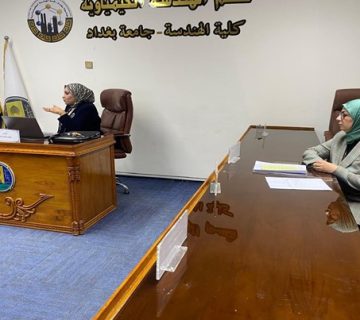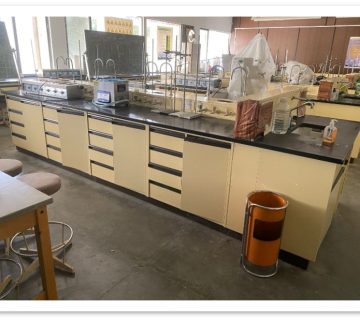The Chemical Engineering Department at the College of Engineering, University of Baghdad, held a Ph.D thesis examination titled:
“Design and Investigation of Different Hybrid Osmotically Assisted Reverse Osmosis Systems for Desalination“
By the student Hassanain Abbas Hassan and supervised by Prof. Dr. Ahmed Faiq Al-Alawy. The examination committee consisted of Prof. Dr. Hasan F. Makki as Chairman and the membership of Prof. Dr. Basma Abbas Abdulmajeed, Prof. Dr. Jasim Mohammed Salman, Prof. Dr. Hayder A. Rasheid, and Assist. Prof. Dr. Sama Mohammed Abdullah. After conducting the public discussion and listening to the student’s defense, the thesis was accepted. The thesis was summarized as follows:
The scarcity of fresh water and its need to sustain life on Earth has encouraged researchers to find new, low-cost, scalable technologies for desalinating water. Thus, the osmotically assisted reverse osmosis (OARO) membrane process represents an innovative approach to achieving moderate water recoveries from high salinity water without phase change. These systems can operate at pressures approximately 50-70% lower than those used in traditional reverse osmosis (RO) systems. This work aims to investigate the performance of OARO and hybrid RO-OARO systems over various designs and operational parameters on recovery and rejection percentage.
The osmotically system was evaluated at initial concentrations of NaCl solution between 5-35.5 g/l and applied pressure range from 2 to 8 bar for 180 minutes using Hi-Tech membrane. The results showed that the flux increased by increasing the pressure and decreased by increasing the feed concentration. Furthermore, flux values were slightly affected by the time of the experiments. The highest recovery was 23.9%, obtained at 10 g/l feed concentration and 7 bar. When poly sodium 4-styrenesulfonate (PSS) was used as an osmotic agent solution (OAS) in the low pressure (L.P.) side of the OARO system, the value of recovery increased by about 11% compared without using osmotic agent solution.
Reverse osmosis unit was followed by an osmotically assisted reverse osmosis unit to form four hybrid systems were used in this work, as follows; RO-OARO (I), RO-OARO-OARO (II), RO-OARO (III), and RO-OARO (IV). These systems have different designs according to the configuration of their feed, diluted, and rejected streams. The studied variables were: feed concentration (4-5.5 g/l), RO pressure (3-7 bar), OARO pressure (3-5 bar), type of membrane (AquaTec, Hi-Tech, and FilmTech), and the use of air sparging technique in high pressure (H.P.) side of the OARO unit. For RO-OARO (I), the FilmTech membrane showed the highest recovery at 31.7%, while the highest rejection was 94.55% for the AquaTec membrane. Using the air sparging technique in the RO-OARO (III) caused an increase in the recovery value by about 6% for 60 minutes. For the same operating conditions, the study revealed that the RO-OARO (III) was the best compared with the other hybrid systems, as it gave the highest values of recovery (26%) and rejection (96.99%) through 60 minutes.
One of the main benefits of the hybrid systems (RO-OARO) in this study is keeping the feed concentration of the RO unit stable compared to desalination using the reverse osmosis system alone. The flux for the RO-OARO (I) exceeds by about 216% (flux = 8.05 l/hr.m2) compared with the flux of RO (flux = 2.55 l/hr.m2) at the same feed concentration (» 4 g/l) and RO pressure (7 bar). It is worth noting that the flux of the RO-OARO (I) system at 5 bar was higher than that of the RO system at 7 bar when used as a desalination system alone. The specific energy consumption values ranged between 1.11-2.71 kWh/m3 for the hybrid systems, while it was 1.3 kWh/m3 for the RO system.
A mathematical model was developed to compute the theoretical flux of the OARO system, taking into consideration the effect of concentration polarization, and compare it with the experimental data, where the correlation coefficient was 88.4%, 98.31%, and 97.8% for the feed concentrations of 5, 10, and 15 g/l, respectively. It was noted that the mathematical model is more accurate at high concentrations. Therefore, it was used to calculate the flux theoretically at very high concentrations and pressures, such as 90 g/l and 40 bar.








